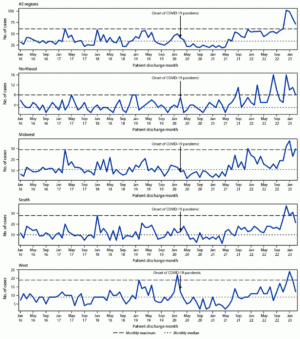As pandemic restrictions eased, pediatricians around the country saw alarming upticks of rare brain abscesses in children under 18 years old, with national cases steeply climbing to a peak in December 2022. That’s according to two studies led by researchers and health officials, which were published together Thursday in the Centers for Disease Control and Prevention’s Morbidity and Mortality Weekly Report.
Even at the height of the unusual surge, the brain infections remained rare overall, and the latest data suggests cases are on the decline. But, the infections are serious and potentially life-threatening. They occur when bacteria, viruses, or fungi enter the brain and an encapsulated area forms around the germs and pus. Bacteria, particularly Streptococcus, appeared to be the main culprit in the recent rise.

Brain abscesses can start in several ways, including from an infected head wound, meningitis, and congenital heart disease, but also more common conditions, such as sinus and ear infections. If not treated promptly, the pockets of pus in and around the brain can lead to rapid deterioration and permanent brain damage, causing severe neurological complications, such as seizures and difficulty with movement, speech, and cognition.
Disrupted diseases
The wave of cases is another example of wonky disease patterns in the wake of responses to the COVID-19 crisis. Unprecedented disturbances to normal life, social distancing, heightened hygiene measures, masking, and improved ventilation led to severe disruptions in normal infectious disease cycles during 2020 and 2021. Influenza virtually disappeared in 2020 and 2021, for instance.
But then restrictions eased, life inched back to a new normal, masks came off, and familiar germs made roaring comebacks, causing unusually high waves of infection, some at unusual times in the year. Take the common RSV (Respiratory syncytial (sin-SISH-uhl) virus), for example. It usually spreads in the fall and winter—like many other seasonal respiratory pathogens. But in 2020, RSV circulation hit historic lows, and as pandemic responses began to lift in 2021, RSV transmission picked back up in the spring, leading to an unexpected high, wide wave over the summer.
It seems that rare pediatric brain abscesses have followed a similar pattern. According to one of the studies published today—led by researchers at the CDC and independent researchers in Kansas, Utah, and Ohio—the onset of the pandemic in March 2020 led to below-baseline levels of pediatric brain abscesses between May 2020 to May 2021. Those baseline levels were monthly median levels (34 cases per month) calculated using case counts from 2016 and 2019, with data pooled from 37 hospitals in 19 states and the District of Colombia.
But after May 2021, when pandemic restrictions were easing and respiratory infections began surging, cases of pediatric brain abscesses began rising, too, with cases above the baseline between August 2021 to March 2023. In December 2022, cases hit a high peak of 102, surpassing the baseline monthly maximum of 61 cases. So far this year, cases have declined from the December peak, but in the latest data from March, they were still above the monthly baseline maximum.
Roaring return
It’s unclear what caused the surge, but the study authors note that it seems linked to surges in respiratory infections that followed eased pandemic restrictions. Brain abscesses “are often preceded by viral respiratory infection and sinusitis, and recent trends might be driven by concurrent, heightened pediatric respiratory pathogen transmission,” they wrote.
In the second study, CDC investigators and experts in Nevada linked a surge of pediatric brain abscesses in Clark County, which encompasses Las Vegas, specifically to when the state’s mask mandate lifted, which was February 10, 2022. Throughout 2020 and 2021, the county’s median number of quarterly pediatric brain abscess cases was 1.5. But in 2022, there were 18 cases, with 16 occurring in the second to fourth quarters of the year—after the mask mandate lifted.
Among the 18 kids with brain abscesses in 2022, their median age was 12 and all but four were male. Fourteen were diagnosed with sinus infections and four had mastoiditis, an infection of the large bone behind the ear that’s usually caused by middle ear infections. Nine had cold-like symptoms before being hospitalized, and five reported not using masks after the mask mandate lifted. All of the children survived.
“Although this investigation did not identify unexpected risk factors for intracranial abscesses, the substantial increase in cases after the mask mandate in Nevada was lifted might be partially attributable to changes in respiratory pathogen transmission,” the authors wrote.
While surveillance continues, health officials have advised doctors to be on the lookout for brain abscess cases, which can be difficult to diagnose. Early symptoms can be nondescript, including fever, headache, and nausea before more worrying symptoms like behavior changes, weakness, changes in speech, and seizures develop. A review study from 2014 estimated that case fatality rates are around 10 percent, but about 70 percent of patients make full recoveries, particularly if the infections are caught quickly.



































